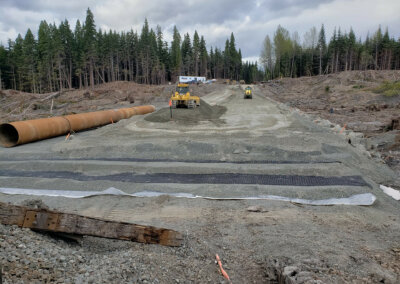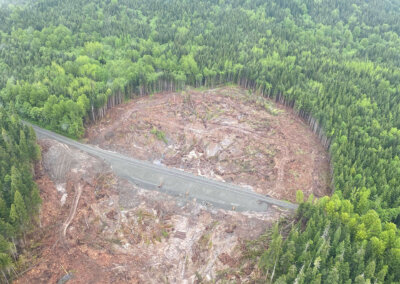About the Project
On the evening of November 25, 2020, an earth flow landslide in a sensitive glaciomarine deposit destroyed 130 m of Canadian National Railway Company (CN) track approximately 10 km south of Terrace, BC.
Within the past century, multiple significant landslides in sensitive glaciomarine deposits have been reported within the Terrace to Kitimat, BC area. The area affected by the slide in November 2020 occurred on relatively flat ground and there was no previous record of significant instability events for the railway track in the vicinity.
Klohn Crippen Berger (KCB) worked alongside CN, consultants, and contractors to investigate the landslide site, complete a test embankment program and detailed analysis, develop remediation options, and provide construction services.
A test embankment was constructed with multiple zones and various reinforcement combinations. Test embankment performance was monitored using instrumentation and results were incorporated into the design analysis, which was progressing simultaneously. This approach enabled the team to manage the potential for reactivation of the landslide during and after construction and increased confidence in the assumptions and criteria developed during the design phase. The test embankment program ultimately directed KCB and CN towards the most appropriate remediation option.
KCB’s design for the new track uses an embankment that is supported by timber piles and geosynthetics. The piles support the weight of the embankment and provide additional shear resistance in the soft, marine clay soils. The design was informed by site observations and continuous monitoring. Additionally, the design utilized sustainably sourced materials – the piles were constructed from regionally sourced timber and the embankment fill is made up from “crusher fines” from a local quarry.
Close monitoring of conditions and simultaneous design modification allowed the track to be returned to service on May 22, 2021.
Approach
Three primary remediation options were considered:
- Pile supported reinforced embankment fill;
- Bridge; and
- Pile supported reinforced embankment fill and partial bridge.
The test embankment program was used to explore these options and ultimately the pile supported reinforced embankment fill option was selected. To divert surface runoff and future potential debris flows, it was decided that steel culverts would be installed at strategic locations and elevations along the embankment.
Limit equilibrium and finite element analyses were carried out to assess the stability of the proposed embankment and optimize the use of timber piles and geogrid reinforcement. All analyses considered live loading from rail traffic. Surcharge loading on the upslope side of the embankment was considered in the limit equilibrium analysis to represent potential retrogression of the landslide, resulting in slide material imparting pressure on the embankment. The finite element analysis was used to estimate deformations and inform the construction monitoring program.
A settlement analysis was performed to assess the long-term anticipated total settlement of the track as well as the differential settlement between rail. The results of the settlement analysis were used by CN to help schedule future track maintenance.
Results
KCB provided design and construction management services on the project.Timber pile installation and the relatively large fill volume across the highly disturbed, sensitive glaciomarine deposits had the potential to destabilize the slide area which required construction activities to be closely monitored. The embankment was constructed in a timely manner with track service restored on May 22, 2021. KCB continues to monitor site instrumentation as part of CN’s ground hazard management program.
Service(s) Provided
Preliminary and Detailed Design
Tender Development and Support
Construction Management
Go back to projects in
View other projects from
Stay in touch with us
Subscribe to our mailing list!
Organization
Connect






